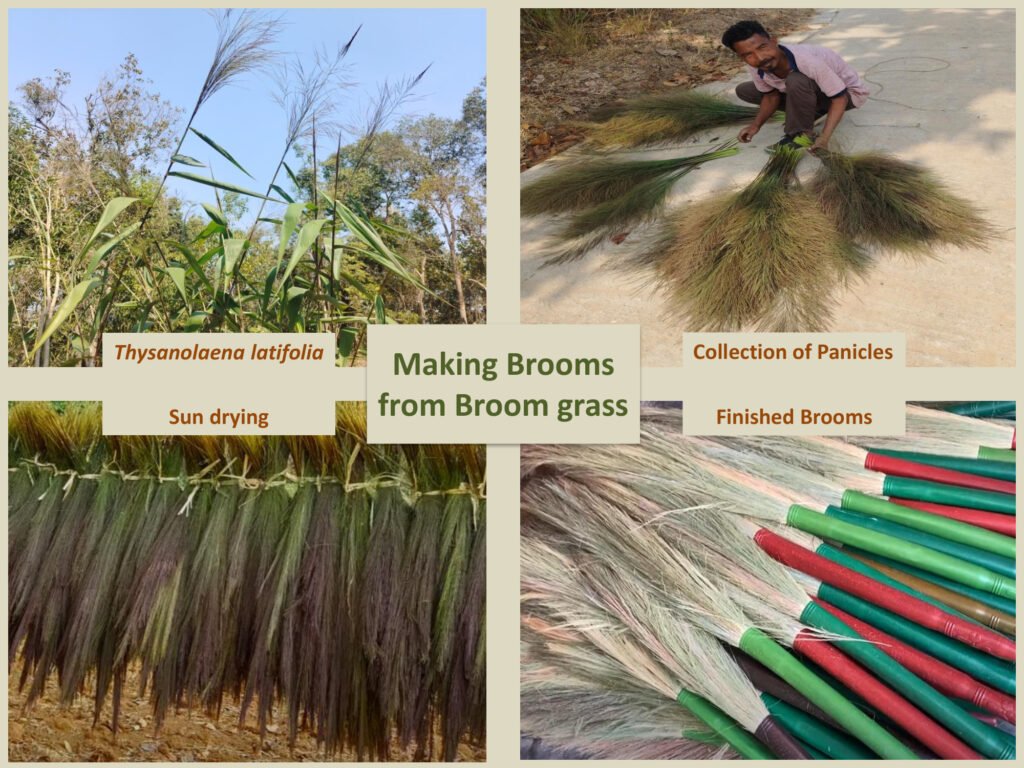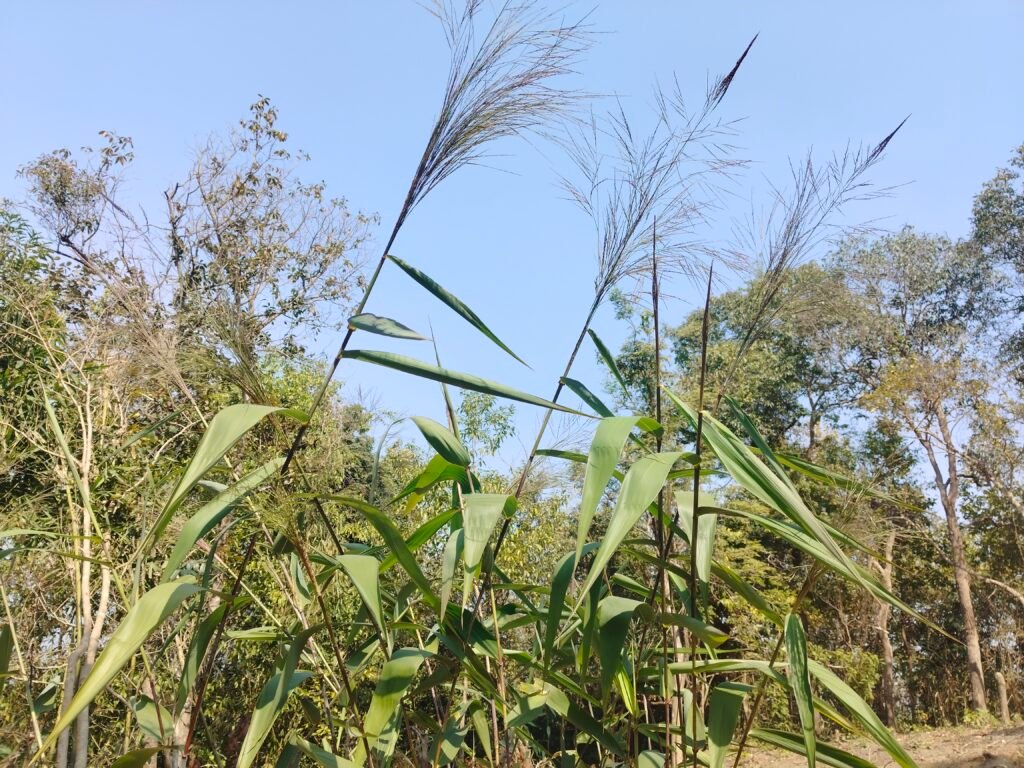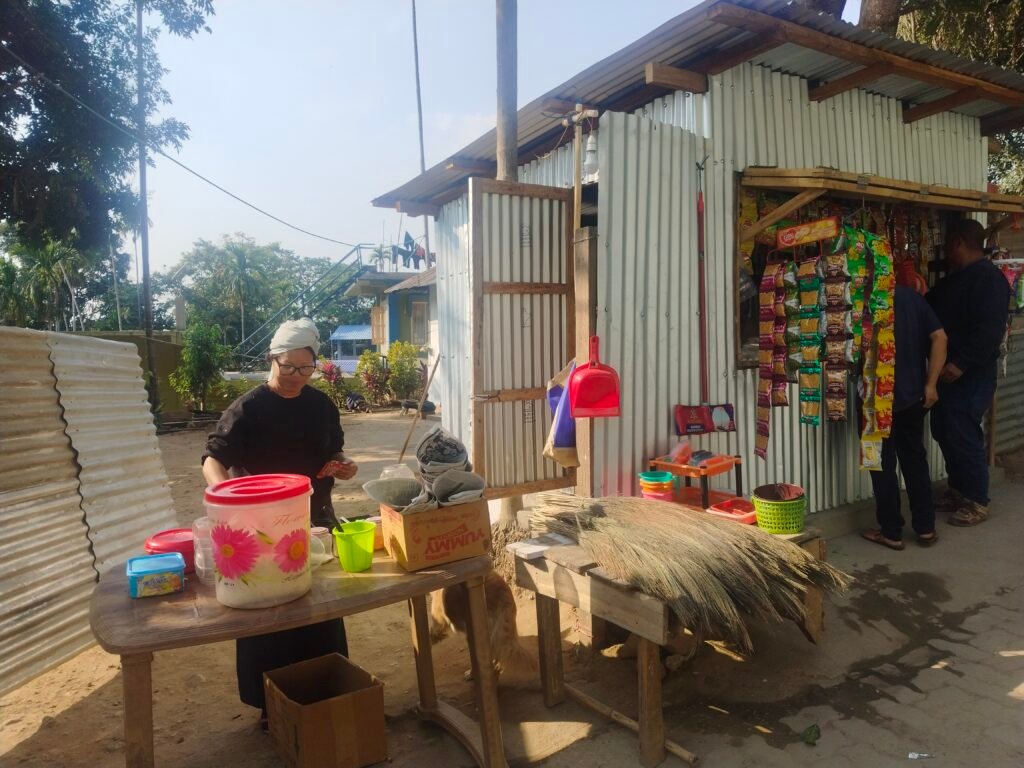lntroduction
One afternoon, while walking from my department to my quarters for lunch, I came across a humble Garo man collecting naturally grown broom grass and bundling it into brooms. With his permission, I captured a photograph of the broom-making process, which instantly reminded me of my strict mother. She would often use brooms to discipline my sister and me whenever we misbehaved. And also, the lesson taught by my father when I mistakenly used a Bandarike (Dodonaea viscosa) broom to clean the cowshed instead of a Bhimana kaddi (Sida acuta) broom. He explained that a Date palm broom should be used for cleaning inside the house, a Bhimana kaddi broom for the cowshed, and a Bandarike broom for the courtyard. These encounters sparked an idea to write a blog on the journey of broomsticks in India, tracing their evolution from simple punishing tool and housebound cleaning to global traded commodity.

A man from Garo Hills of Meghalaya is collecting naturally grown broom grass for making brooms
In India, broomsticks, often called Jhadu or Bhuari, have been an integral part of every household for centuries, serving various purposes beyond just cleaning. Generally, brooms made from locally available natural materials like twigs, shrubs, and inflorescences are deeply rooted in Indian tradition, with different regions using specific types of grass or plants to create their brooms depending on the local terrain and species availability. It has held a symbolic presence in Indian culture, being associated with disciplinary tools, daily necessity and even religious significance. Over a period of time, what was once a disciplinary tool for many strict Indian mothers or elders and a humble household tool, now transitioned into a significant economic contributor, driving employment, trade, and even sustainability efforts at global level.

Naturally grown Broom grass in Tura, Garo Hills of Meghalaya
Cultural and Social Significance of Broomsticks
Broomsticks hold a significant cultural and religious meaning, and are considered a sacred utility in most households. Traditionally, broomsticks are often used first thing in the morning to sweep the courtyard, signifying the welcoming of prosperity into the home and drive away negativity and bad luck. Beyond this, the broomstick finds a sacred place in Hindu traditions. Broomstick is often linked with being associated with the Goddess Lakshmi, the deity of wealth. In Indian households we get told off by our elders not to take old brooms to new homes that bring negative energy from the previous dwelling, sweep at night that can invite negative spirits or misfortune and to store the broom with the bristles facing upwards which is often thought to bring good luck and protection. In some cultures, stepping on a broom is considered disrespectful and can be linked to bad luck.
Broomsticks as a Rural Livelihood
Various twigs, shrubs, grasses, palm midribs and fronds are used for making broomsticks in different parts of the country, depending on the availability of raw materials. Among various raw materials used for brooms, Broom grass is often considered one of the best broom materials due to its natural durability, ability to effectively sweep a variety of surfaces. Karbi Anglong is the largest producer of brooms in India. Cultivation of broom grass is comparatively easy and requires only small financial inputs. It is readily available and sustainable growth on marginal lands, and its positive environmental impact by preventing soil erosion on steep slopes, making it a practical and eco-friendly choice.

A woman in the vicinity of Tura’s Gandhrak Dhara is selling broomsticks for fifty rupees each.
Brooms are broadly classified into two types; hard brooms and smooth brooms. Hard brooms are used to clean courtyards, cowsheds, and outdoor spaces while smooth brooms are used for indoor cleaning. The hard brooms are made from the whole plant of Sida acuta, midrib of coconut, palm fronds and other sturdy materials. Smooth brooms, on the other hand, are typically made from grasses, require prior expertise and are relatively costlier.
Broomstick industry is one of the major cottage industries in rural and hilly areas. As it provides livelihood opportunities to tribal and backward places. Tribal and marginalized communities serve as custodians of traditional broom making-knowledge, passing down their skills through generations. The selection of plant species, harvesting techniques and processing methods require prior expertise, which is often taught by elders within these communities. Broom making provides vital-livelihood for rural households, particularly among tribal communities, contributing to their economic sustainability and cultural heritage.
List of Key Species and Communities Engaged in Broom Making
| Scientific name | Common name | Habit | Parts used | Major Region | Major Communities |
| Cajanus cajana | Pigeon pea | Shrub | Matured shoots | South and Central India | – |
| Cocos nucifera | Coconut | Palm | Midribs | Southern India | – |
| Dodonaea viscosa | Broadleaf hopbush | Shrub | Young branches | South and Central India | Irula, Kurumba, and Soliga |
| Sida acuta | Bala | Shrub | Matured shoots | South and Central India | Irula, Kurumba, and Soliga |
| Thysanolaena latifolia | Broom grass | Grass | Panicles | North-East and South India | Karbi, Tiwa, Khasi, and Adi Karnataka |
| Bamboo spp. | Bamboo | Grass | Culm | Western India | Harijan in Maharashtra |
| Elaeis guineensis | Oil palm | Palm | Fronds and Midribs | South and North-East India | – |
| Livistona jenkinsiana | Toko palm | Palm | Midribs | North East India | Adi tribes in Arunachal Pradesh |
| Phoenix sylvestris | Date palm | Palm | Fronds | South and Central India | – |
| Borassus flabellifer | Toddy palm | Palm | Fronds | South and East India | – |
Economic Growth and Export Potential of Broomstick Market in India
India ranks as the second-largest producer of brooms in the world, holding a significant chunk of the market for broom products in a global broom market. In 2025, the Indian broom market was valued at USD 74.8 million and is projected to grow at a CAGR of 5.6% from 2025 to 2031. The rising demand from key end users, such as households, hotels, restaurants, hospitals, malls, educational institutions, is a major driver of the market. Furthermore, increasing disposable incomes among Indian consumers have increased demand for high-quality brooms at reasonable prices.
Challenges Faced by Traditional Broom Makers
Broomstick makers, especially those involved in traditional and small scale production, face several challenges. Sustainable sourcing of raw material is difficult due to deforestation, land conversion, and overharvesting. Price fluctuation is also a major challenge faced by broom makers due to seasonal availability and market demand, affecting income stability. In addition, manual broom making is labour intensive but workers receive lower wages. Many broom makers sell raw or minimally processed broomsticks rather than finished products with a better market quality. Nowadays, cheaper, machine made synthetic brooms and imported alternatives are affecting demand for naturally sourced handmade broomsticks. Traditional broom makers have limited awareness, branding and consumer friendly brooms, making it difficult to reach premium markets.
Sustainable Harvesting and Conservation Issues
Impact of overharvesting on biodiversity and soil conservation: Currently, unsustainable harvesting of broom-making species such as Broom grass from Assam, Arunachal Pradesh, Jharkhand, Meghalaya, and Uttarakhand, Coconut-leaf from Kerala, Tamil Nadu, and Karnataka, Date palm fronds from Rajasthan and Gujarat, and Saccharum species stalk from Madhya Pradesh and Chhattisgarh caused loss of species diversity and soil erosion. Some of the important impacts on biodiversity are overharvesting hampers regeneration, risking species decline, and diversity depletion affects insects, birds, and pollinators and excessive extraction degrades habitats and hinders regeneration. Similarly impact on soil conservation are loss of grasses weakens slope stability, reduced organic input affects soil quality, and weakened soil structure increases displacement hazards.
Modern Innovations and Marketing
Introduction of eco-friendly and designer brooms: In the context of increasing environmental awareness, the demand for sustainable products is on the rise. Due to difficulty in disposal of plastics, increased awareness among consumers, both manufacturers and consumers are opting for eco-friendly and economically reasonable broomsticks. Locally designed eco-friendly and sustainably grown raw materials are the best alternative for synthetic brooms. Manufacturers are focusing on introducing innovative product designs which offer better efficiency and ease while using them thereby providing competitive advantage against existing players.
Many researchers are involved in developing hybrid broom grass cultiver for better quality. Machines are used to efficiently harvest broom grass leading to better yield and reducing costs. Mechanized processing of the grass allows manufacturers to precisely cut and shape the broom grass bristles creating consistent and effective sweeping patterns. Automated production helps to ensure consistent quality and high production volume.
Branding and marketing: Natural brooms have evolved significantly in design and branding over time, adapting to changing consumer preferences, market trends, and sustainability concerns. Traditional brooms were made from locally available material like broom grass, coconut midrib and palm fronds while modern variants use hybrid material including bamboo handle, recycled plastics, and ergonomic grip for durability and use. The redesigned brooms now come up with adjustable handles, soft grips, lightweight yet sturdy materials and varied bristle density for different cleaning needs. Earlier, brooms were primarily sold in local markets and general stores now available on e-commerce platforms, with visually appealing packages, eco-certification and influencing marketing.
Conclusion
From a simple household necessity and disciplinary tool to a crucial player in the global economy, the journey of the Indian broomstick is nothing short of remarkable. Brooms, a symbol of cleanliness in the Swachh Bharat Mission, also embody the spirit of Vocal for Local by supporting indigenous artisans and promoting self-reliance through locally made cleaning tools. What was once confined to the corners of Indian homes has now swept across international markets, generating employment, supporting local artisans, and promoting sustainability. This transformation underscores the potential of everyday objects to shape economies and cultures alike. However, traditional broom makers are facing several challenges such as shortage of raw materials, price fluctuation, low wages and labour issues, competition from synthetic and machine made brooms and limited awareness and branding. Hence, there is a need of the hour to support traditional broom makers by providing policy and financial support, upskilling, branding and marketing support. Sustainable Solutions such as regulated harvesting, community led conservation, agroforestry, and policy interventions can balance economic benefits with environmental protection.

